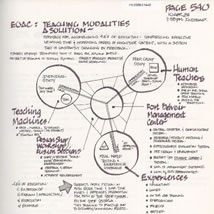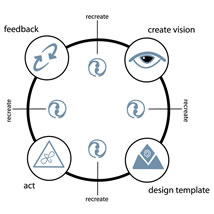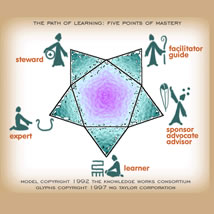How
I Wanted to be Educated |
| While
I enjoyed many of my educational experiences up
to the day I left school for work, there was much
of it that I found annoying and a profound waste
of time. During my High School years, I thought
about
this
a great deal; wondered why the education process
was the way it was and slowly formulated a plan
of how I thought a school
should
be run.
I
had
a chance,
in 1956, to present this concept at a conference
of educators in San Francisco [link: the student environment]. It intrigued them
- I could tell - however,
it clearly did not match with their paradigm. There
was no way they could fit what I was saying into
the structure that they considered to
be education. At this time I was just staring my
work in architecture
with
the
plan
to
go to
the Architecture School at
University
of California, Beckley the following year.
Why I did not do this is highly relevant to what
follows; the full story is told at the link below below. |
story_why_I_did_not_go_to_school |
| The
story of Welton Beckett, the Tower and the
Professor is one
where circumstances conspired to push me down a
path different than the one I had
planned. In June of 1956 [link: the promise - 1956] I
finally accomplished my goal of several years to
find work in an architect’s
office - in this case the San Francisco office
of Welton Beckett and Associates. Instead of finding
the world of philosopher designers that I had envisioned,
I found a world of frustrated, angry and prematurely
burn-out, bitter professionals who had come to
the point of open hostility to any notion of ARCHITECTURE as
a noble and life-giving
art [link: what is architecture]. It was a shocking
experience. |
| I
was, even at the young age of 17, used to being considered
out of the main stream of the 1950s “Pleasantville”
paradigm; however, the full scale assault that
I was to endure in this environment lives with
me even to this day. It was not that my ideals
or specific ideas were attacked - I could have
understood this and I was prepared to stand for by point of view and also learn ways to improve my ideas. It was that very fact that
I had them that was the basis of their condemnation. We never discussed the issues of architecture, it was always an attack on the idea that any of it mattered. |
| In
this period of recoil, I designed my first major
work. It was an exercise that I gave myself one
day walking
in the San Francisco’s Golden Gate Park, the question I asked
was: “why put a park in a city?”
”Why
not put a city in a park?” The project [link: vertical housing project] was
aired on Public television [link: what is this?] and I was naive enough
to believe that
this thesis would earn my way into the community
of the drafting room - of course the very opposite
was true. I realized, then, that what I was facing
was not rational criticism but hatred aimed not
at me but at the idea of architecture as a sacred
trust. I knew nothing, of course, of the gentle
art of easing innovation into a culture, I was
blunt to a fault and the battle lines became drawn.
It was along road from this place to the the idea
of successful collaboration without compromise. |
| The
TV show did provoke a fair amount of positive response
and one of these was from a professor of architecture
at Beckley - it was this that really did me in.
The professor turned out to be at once over effusive
in his compliments, pandering in his attitude and,
at the same time, aggressive in his excuses for
why
nothing
like this
work would ever be possible - I have forgotten
his name but I will never forget his soul [link: the professor] . |
| The
sum of these experiences, so different than the
world I grew up in, convinced me that I would not
subject myself to whatever it was that had so profoundly
crippled these young-in-years but so aged-in-heart
architects. They were educated - “lead out to” - this condition.
I was repulsed. This was and remains a basic contrast between
two
world
views.
At that time, to me, a
vast
dilemma
that
offered no mediation. I was to realize, many years
later,
that humankind was on
the cusp [link: rebuilding the future] of having to decide
what kind of a world we were to have - to this
day, at this moment, we stand at the fork in the
road. The power
of gods [link: the monkey’s paw] with
the mentality of a child distracted by all the toys in the marketplace with no awareness of the consequences [link: a future by design not default] of their making or use. Humankind is yet to decide if we will have a future let alone what kind it will be. |
| I
made up my mind that I would not abandon a positive
view of the world - and of human potential - that
I would
never succumb to this destruction; I decided I
would find the means to rid our species from the
chains they had imposed on their own soul and
mind - from the limits that had become accepted
as given, as law. I determined that I would return
the practice
of life
as art [link: to hold an unchanging youth] - as quest [link: the art of quest] -
to the realm of the practical. This became my mission [link: mg taylor mission].
No matter what
mistakes I have made, the times I became lost
and confused, I never have given up this desire [link: what do you want - 1858] -
and I never
will [link: confessions of an unrepentant idealist - 2000]. |
| It
was not until I met Gail, nearly 20 years later,
that I worked with someone, educated in education,
who had drawn similar conclusions and had put them
into action both in her teaching and with the creation
of the Learning Exchange [link: the learning exchange kansas city]. |
| With
the creation of MG Taylor, we formalized each of our individual
past work into a System and Method that treated the educational and creative processes
as essentially the same process. For a quarter
of a century, we have applied this method in a
wide
variety of
settings and applications from grade school through
university levels. Given the experiences
we have had by doing this, our convictions, strong
in the beginning, are even more so today. |
| We
believe the educational process is: |
| First
off, a natural and easy process for
nearly everyone. It is our society’s
present approach that has made it
expensive, difficult, political and,
now, increasingly irrelevant to the
future requirements of our citizens. |
| That
while it is possible to bring system
and method - and measurable results
- to education, every individual is
unique and has their own learning and
creative style. The method has to employ
these unique attributes as an asset
not something to be ignored and “rolled
over.” |
| The
purpose of education is not to prepare
someone to get a job or prepare them
to fit some social norm; the purpose
is to prepare and facilitate them reaching
their full human potential - profitable
creative work and social contributions
are the natural consequences
of education - not the goal. |
| Knowledge
is not passed on from one person to
another - the learner is not a vessel
that wisdom is poured into; the true
process of education is such that
the learner is
stimulated to, themselves, build a
new construct in their own body/mind.
As the learner advances in their learning
skills, their awareness of how they
do this increases and they progressively
take control of their own process of
education - a condition necessary for
maturity to be reached. An individual learning how they learn and create - and how to do both in the world they live in - is the core achievement of an environment and system of education. |
| While learning and creativity are unique to each individual, GroupGenius® is real and the experience and practice of it is not in conflict with the demands of individual learning and creativity. In fact, both learning and creating are intensely social enterprises where all build on the work of each other. Although individuals have their own style of learning and creating that never should be violated, a properly designed and facilitated group process stimulates GroupGenius to emerge. This establishes a learning environment of another order which encompasses all styles. This experience greatly accelerates productivity and compresses time. The character, quality and magnitude of the result is increased. So is, often, the pleasure of the experience. |
|
|
| Since late 2004, a number of educators, who have
been thinking and working along similar paths have
found their way to us and us to them. It seems
that the old education paradigm - so strong and
tenacious - is shifting; as Heinlein says “when
its time to railroad, people build railroads.” Our work with these educators
is prompting the creation of several NavCenters
in support of their work - an unprecedented leap
in the number and scope of NavCenters dedicated
to learning that spans all stages of life. In addition
to this, there are several Community NavCenters
trying to spring to life. “Trying” is the sense that money always seems to be the issue with community projects - one wonders why. |
| There
are four core models that provide the basis for
our approach to education: |
|
|
| The
5 Es of Education Model outlines the modes that both
teacher and student have to bring together, simultaneously,
in order to create a genuine learning experience.
The weight between these five, may be different in
any circumstance yet all must be present. This model is of an emergent process, iterative and recursive through many cycles of experience. |
|
 |
| The
Teaching Modalities (or Administrative Method) Model describes five
components of a life-long, institutionalized education
delivery system: self-paced, computer aided learning,
human mentoring by subject experts with peer dialog,
connection to the work experience - all integrated
by a NavCenter. |
|
 |
| The
Recreation Process Model outlines four critical
transformations as an idea progresses
from abstraction to material manifestation; it stresses
that the idea must be recreated each time
it moves from the form of mind to media to artifact
to to built lived experience. It then, of course, starts the journey over. High frequency, low magnitude cycling is best. |
|
 |
| The
Five Points of Mastery Model identifies
that to sustain the path of learning the explorer
must seek and ultimately obtain competency and ultimately the mastery of the steward, facilitator/guide,
advocate, learner and expert - learning, teaching and creative, collaborative work
are the same thing; the skill of one requires the
other and all must be practiced to master. |
|
| These
Models cover a range of key aspects of the education
and recreation processes. The 5Es set the conditions
necessary for learning for both teacher and student
working separately or together. The Teaching Modalities Model describes a systematic system for individual learning, peer group leaning and work as an integrated lifelong experience. The 4 Step ReCreation Process Model show the transitions as idea becomes reality. Learning and creativity are essentially the same processes. Learning is creativity aimed inward at self development. Creativity is learning aimed outward at making something - self expression. Both are transformational - they require recreation. Notice that what we call today, recreation - which is often aggressively mindless - is a distortion of the true meaning of the word. The Five Points of Mastery Model expresses two important aspects of learning: that the teacher and the student are both learner and teacher, respectively, and that they have to accomplish competency in all five mastery roles in order to become a true lifelong learner. |
| My
childhood learning experiences were unusual and varied.
The most valuable of these were not in a formal schooling
situation [link: inventing a machine] which was a mix of
extraordinarily good experiences and some rather
bad ones which provided to be a valuable instruction in their
own way [link: that does not look like...]. |
For further comments on my educational experiences, go to:
|
The Education of a Heretic
I do not think I am a heretic yet the orthodoxy in several professions tends to think I am. A set of circumstances and subsequent experiences set me off in a direction from which there was no recovery. Be this good or bad in an open question yet to be answered. Click on the graphic to see how it all began...
|
|
Although, I was luck enough to have some unusual and valuable opportunities that were far from average then - even today - I do not believe my education was that much different that what many experience - it was not designed to meet my requirements it was designed to fit the social model of the time. I rebelled against this with results that were largely beneficial and some that were not. Many are not so fortunate. We are not educating knowledge workers for a 21st Century reality which includes a high prospect of the singularity happening in their lifetime [link: a future by design not default]. This is a silent tragedy in the making. |
|
|
| Return
To The Second Decade |
|
|
|
| School of the Future - Today |
|
|
|
| GoTo The Student Environment |
|
|
|
\

SolutionBox
voice of this document:
VISION • STRATEGY • EVALUATE
|
|
posted
July 3, 2005
Revised:
March 10, 2008
• 20050703.456701.mt • 20060202.110912.mt •
|•20080310.451200.mt •
note:
this document is about 230% finished
Copyright® Matt
Taylor 2005, 2006, 2008
me@matttaylor.com |
|
|